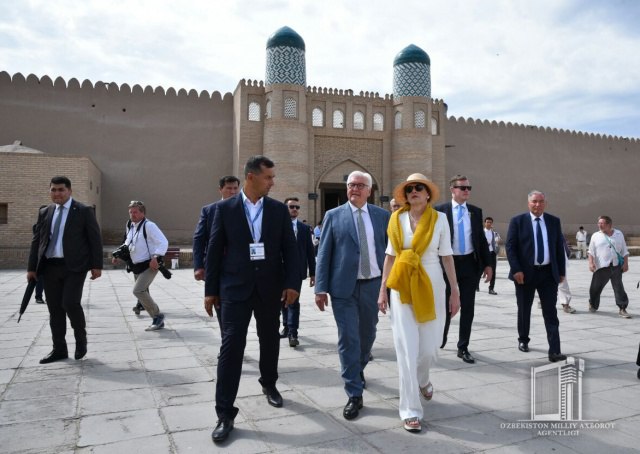


Federal President of the Federal Republic of Germany Frank-Walter Steinmeier together with his spouse visited the historical center of Khiva, Ichan Kala.
The ancient complex has a long history. Most of the monuments that embody the unique traditions of world architecture tell about the centuries-old history of the city.
The guests visited the ancient complexes Ark, Pahlavan Mahmud, Kazi Kalan madrasah, Kalta Minor monument, and other sights.
The guests were impressed by the unique architectural solution of Muhammad Aminkhan madrasah and the minaret located next to the madrasah.
Muhammad Aminkhan minaret was built in a peculiar style, taking into account sunrise and sunset, therefore the color of majolica does not change. The minaret, erected with the use of blue and green colors, manifests itself in bright and colorful colors, delivering delight to the human soul.
From time immemorial Khiva was not only a trade center but also a center of intercultural and interreligious tolerance. This is also evidenced by the lifestyle of the German Mennonites, who had taken a worthy place in the history of Khorezm of the XIX century, their life with locals in peace and harmony.
German Mennonites, who by the will of fate were in Turkestan, settled in Khorezm. The place of their settlement in Oqmachit – a German European-type town developed as a center for handicrafts and trade.
These historical connections and memories are captured today in the memory of Khorezm people through the museum exposition operating in the territory of Ichan Kala.
Delegation of Germany also visited the Mennonites of Oqmachit museum at the State Museum Ichan Kala and got acquainted with the history of the complex.
The guests were briefed about the lifestyle and participation of German Mennonites, who lived in Khiva Khanate in the 90s of the XIX century.
Most of the patterns of historical monuments in Khiva do not repeat each other. The images that form a single composition embody the peace and harmony among peoples, their good aspirations in the name of creating a common future that has been established in the ancient town with a millennial history.
The German Mennonites, who were also skilled craftsmen and carpenters, made an enormous contribution to the landscaping and construction work carried out in the city. From historical documents it is known that German farms that had moved to Khiva actively participated in construction of Kusha darvoza city, post offices, telegraph offices, hospitals, Qibla Tozabog and official reception of Isfandiyarkhan, combining elements of European style and national architecture.
The museum’s exhibits narrate the history of the German Mennonites, who lived for a short time in Khiva Khanate, but took a worthy place in the hearts of Khiva people, their artisan activities and true humane qualities, a brotherhood of representatives of different religions.
“Uzbekistan is an amazing country. On the example of ancient Khiva, we received even more information about the centuries-old customs, the hospitable people of this sunny land. We were told about the conditions created here for German Mennonites. At that time, people who were representatives of a different nationality, religion, and distinguished way of life lived in harmony, which is a vivid example of the prevailing brotherhood and unanimity in the consciousness of our peoples”, said Frank-Walter Steinmeier.



